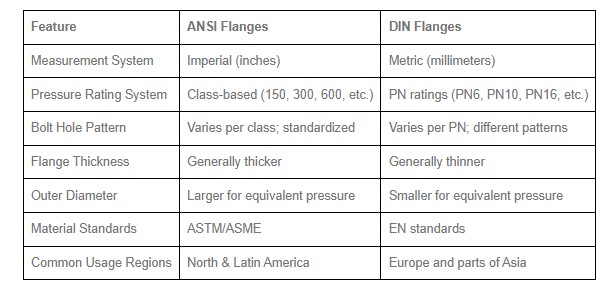Flanges DIN
Across the pond, you will find the Deutsches Institute fur Normung (DIN) flange specification, consisting of a variety of European styles which have been unified into one code for the purpose of commonality. Designation as a DIN flange by the German Institute of Standardization assures the user of design quality the way an ASME flange would here in America. Although much less common than ANSI/ASME steel flanges in the United States, many of our international customers request flanges to these specifications for a variety of applications such as imported steel vessels, cargo ships, and other infrastructure which may consist of metric pipes/valves and European designed equipment.
The subset flanges under the DIN standard consist of the same style of flanges in the United States, including the most commonly used slip on flanges, weld neck, flanges, and blind flanges. Adapter flanges can be custom made to end user requirements for the mating of American flanges to international ones, however we find it is a much more common and easy solution to provide DIN flanges to mate to existing equipment.
The most common metric type flanges fall under the following categories:
DIN 2501 through 2503 for flat ring flanges
DIN 2512 through 2519 for alternate face flanges
DIN 2627 through 2633 for weld neck flanges
DIN 2641 through 2642 for lap joint flanges
DIN 2565 through 2569 for threaded/companion flanges
DIN 2527 for blind flanges
*DIN stands for “Deutsches Institute fur Normung” and more information can be found on their website: https://www.din.de/en
What is the DIN Standard?
It is the official German national organization responsible for developing and publishing standards for a vast range of products, services, and processes. While DIN standards originated in Germany, they are highly respected and widely used internationally, particularly throughout Europe.
When a product, such as a flange, is "DIN compliant," it means it has been manufactured to the exact specifications set by a particular DIN code (e.g., DIN 2576 or DIN 2633). These standards precisely define every critical attribute, including:
Dimensions and Tolerances: Bolt hole size and placement, flange diameter, and thickness.
Material Specifications: The types of steel or alloys that can be used.
Pressure-Temperature Ratings: The maximum pressures the flange can safely withstand at specific temperatures.
For a company like Flanges DIN, specializing in these standards means guaranteeing that every part we sell is consistent, safe, and perfectly interchangeable with other DIN-compliant components anywhere in the world.






Where is the DIN Standard most used?
DIN standards are most applicable in Germany and throughout continental Europe.
They are specified when a project, piece of equipment, or facility is designed using European engineering and metric-based measurements.
Here’s a breakdown of the specific locations, industries, and scenarios where you'll encounter DIN standards:
Dominant Market: Germany and most of Europe. DIN standards are the default for industrial and manufacturing applications in this region.
Global Use: They are also widely used in parts of Asia, South America, and the Middle East, particularly on projects where the lead engineering or major equipment (like pumps or turbines) originates from a European company.
The U.S. Exception: In the United States and North America, the dominant standards are ASME (American Society of Mechanical Engineers) and ANSI (American National Standards Institute). U.S.-based industries, especially oil and gas, overwhelmingly use ASME standards.
Key takeaway: DIN and ASME flanges are not interchangeable. They use different measurement systems (metric vs. imperial), have different dimensional tolerances, and have different bolt-hole patterns and pressure ratings (PN vs. Class).
Key Industries for the DIN Standard
DIN standards are prevalent across almost all manufacturing and engineering sectors in Europe. Key industries include:
Automotive: As a powerhouse of German engineering, the automotive industry relies heavily on DIN standards for everything from fasteners to testing procedures.
Chemical Processing: European chemical plants are almost exclusively built using DIN-compliant pipes, valves, and flanges.
Power Generation: This includes both traditional and renewable energy sectors.
Maritime & Shipbuilding: This is a major industry for DIN-compliant components. Ships built in Europe (or for European clients) will use these standards for all onboard piping systems.
Heavy Machinery & Manufacturing: Any industrial equipment manufactured in Germany or Europe for global export will typically be built to DIN specifications.
Water Treatment: Many municipal and industrial water systems use DIN-specified components.


When They Are Most Applicable: Practical Scenarios
You are most likely to need DIN-compliant flanges in three specific situations:
MRO (Maintenance, Repair, and Operations): This is the most common scenario in North America. A U.S. plant may have a specific piece of machinery that was imported from Germany (e.g., a pump, a compressor, or an entire processing line). When that equipment needs a replacement flange or part, an ASME flange will not fit. You must source the specific DIN-standard part to perform the repair.
New Projects with European Engineering: If a company builds a new facility in the U.S. but the project is designed by a European engineering firm, the blueprints will often specify DIN (or the equivalent EN) standards for all components.
Exporting Equipment: A U.S. manufacturer that builds equipment (like a pressure vessel or a processing skid) that is being exported to a customer in Europe will be required to build it using DIN/EN-compliant components to meet the customer's and regional safety regulations.


DIN vs ANSI: Key Differences
Measurement System
One of the most obvious differences between DIN and ANSI flanges lies in the measurement system. ANSI flanges use inches, adhering to the imperial system, whereas DIN flanges are based on metric units.
This fundamental distinction impacts every aspect of flange design and compatibility, making direct interchangeability problematic.
Pressure Ratings
ANSI flanges employ a class-based pressure rating system, where classes such as 150, 300, or 600 indicate the maximum allowable pressure. DIN flanges use PN (Pressure Nominal) ratings, like PN16 or PN25, which roughly correspond to ANSI classes but are not exact equivalents. For example, PN16 approximates ANSI Class 150 but differs in exact pressure limits and design factors.
Bolt Hole Pattern & Diameter
The bolt hole pattern is a critical factor in flange compatibility. ANSI and DIN flanges differ significantly in bolt circle diameter (BCD), the number of bolt holes, and hole size. This difference means flanges from one standard generally cannot be bolted directly to the other without adapters or custom solutions.
Flange Thickness and Outer Diameter
Another significant distinction is in flange thickness and outer diameter. Generally, DIN flanges tend to be thinner than their ANSI counterparts for similar pressure ratings. The dimensional variations between the two standards are substantial enough that attempting to mate DIN and ANSI flanges directly may lead to leaks or mechanical stress.
Material Specifications
ANSI flanges follow material specifications such as ASTM and ASME standards, including grades like A105 and A350. Conversely, DIN flanges use European norms, such as P235GH or stainless steel grade 1.4301. These material differences reflect regional metallurgical standards and can affect flange selection based on corrosion resistance, temperature rating, and mechanical strength.
Comparison Table: DIN vs ANSI Flanges

